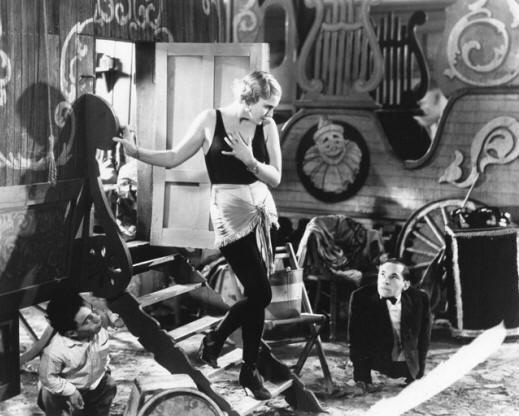Double Bill: Freaks + The Devil Doll
Dir. Tod Browning, English, 1932 + 1936
-
Sun 16 May 2010 // 19:00
/ Cinema
Tonight is a very special treat: Freaks is simply one of the most mind-blowing films ever made. shocking, beautiful, true - perfect. Tonight we are very excited to have a double bill, with Freaks, and another film from Tod Browning - Devil Doll.
Both films on new 35mm prints from the British Film Institute. A very special treat that some of us are just stupidly excited about.
FREAKS (1932, 64min)
Here is an article about the film from Lord Leigh Park, one of the volunteers of the Star and Shadow Cinema
Freaks is a film that could never be made today. It’s miracle enough that it was made in 1932, and as time goes on, shockingly wonderful that it was made at all. Tod Browning’s masterpiece is almost as challenging to watch in 2010 as it would have been on its release.
The Plot
The story is simple enough: man inherits money, woman pretends to love him in order to get her hands on the cash, all the while carousing with the alpha male in the other caravan. Woman attempts to poison newly rich husband and run away with money and man. Only thing is, our hero is a midget, his tormentor a trapeze artist, and her beau the circus strongman.
Having overheard the trapeze-iste and the strongman plotting to murder our tiny hero, the freak show performers, variously formed (including a human chicken, an armless girl and a hermaphrodite), pursue and attack the conniving couple, mutilating them with knives and guns.
Hollywood in the thirties wasn’t quite ready for Freaks. In fact it wouldn’t be ready for another forty years, when midnight showings brought the film to the attention of a cult audience that included cinephiles such as David Lynch and John Waters.
 Director: Tod Browning
Director: Tod Browning
Tod Browning, the director of Freaks, was no hack, nor indeed was he an avant-gardist. He’d run away from home to join the circus, performed in blackface in vaudeville, and acted in films by his mentor DW Griffith.
After a car accident he went into directing and worked for Universal and MGM, making the classic Lon Chaney Dracula. In all he directed 57 films before he made Freaks and despite living until 1962, he made only four films after. You didn’t win awards for cinematic portrayals of disability in the thirties.
Eugenics
In the early part of this century, and well into the forties, Eugenics (selective human breeding – essentially weeding out the weak and sick) was a respectable field of study. Hitler advocated eugenics, but so did Winston Churchill, who in 1910 supported a Parliamentary Bill to introduce forced sterilisation of the ‘feeble-minded’.
In the US, as many as thirty States adopted legislation to compulsorily sterilise certain individuals. California alone performed 60,000 sterilisations, while the Nazis (who between 1933 and 1945 performed just under half a million operations of this sort) cited the US as their inspiration at the Nuremberg Trials. Racism was a primary motive for many of the operations that took place in both Nazi Germany and the US. Under capitalism, communism and fascism, Eugenics was seen to be about improving mankind, in much the same way as slum-clearance, public sanitation, and mass innoculation. On the edges of this world lived the cast of Freaks. Conjoined twins, bearded women, human torsos, pinheads.
Actors in Freaks
The actors in Freaks were real side-show freaks, people who’d worked in circuses all their lives. The public paid to see them in all their malformed wonder. Prince Randian, the aforementioned ‘human torso’ was born without arms and legs and was brought to the US from British Guyana by PT Barnum. His act included shaving, writing, painting, and rolling and smoking a cigarette (after lighting a match using only his lips, Randian asks an able bodied man, in English: "Can you do anything with your eyebrows?" – his only line in the film).
He spoke four languages, married, and had four children, in addition to a career lasting 45 years.side. Sound like a candidate for sterilisation to you?
Film edited down by MGM
When Browning delivered Freaks to MGM, it was savagely edited (so savage that the original edits have been lost). The punishment meted out on the aerialist and her Atlas included castration, amputation and tar-and-feathering. MGM performed their own operation, reducing the length of the film by a third, and adding a happy ending.
Banned
Despite the cuts, the film was banned in Britain for thirty years. Browning’s cast seem to have had their revenge however. The film continues to divide audiences, but it also continues to confound its critics and influence its supporters. David Lynch took the movie as a direct influence on The Elephant Man, and the Ramones incorporated the wedding ceremony song into their own Pinhead (“Gabba, gabba, we accept you, we accept you, one of us").
Browning’s challenge, foregrounded by the extraordinary actors in Freaks, is to look beyond the surface of Hollywood, and decide whether physical form obscures or covers up (for lack of) creative talent.
 + THE DEVIL DOLL (1936, 78 min)
+ THE DEVIL DOLL (1936, 78 min)
An escaped Devil's Island convict uses miniaturized humans to wreak vengeance on those that framed him.
Here is an article about the film written by Adrin Neartrour, one of the volunteers of the Star and Shadow Cinema
Devil Doll - 1936 - Dir: Todd Browning - With: Lionel Barrymore - Maureen O’Sullivan
Script Eric von Stroheim, Garrett Fort, Guy Endore
Devil Doll is the final crack of the whip for Todd Browning: his last show as the heretic Ring Master before being run out of town by the Hollywood Inquisition.
Like many a strange dream, Devil Doll made up of a number of discrete sections, interrelated but characterised by breaks in continuity. The discontinuities resolve themselves into Browning’s meta circus of life, in which the disinherited invest the centre of the ring with their acts of will. As in dreams and circuses, the discontinuities of DD don’t matter because the strength of the underlying logic drives the imagery and story. We take each sequence, or act as it comes.
Revenge
From Devil Doll’s opening shot of a searchlight beam blasted straight out from the screen into our eyes, to the strange Parisian toyshop with its miniaturization sequences, we are led into a cycle of revenge. With sardonic charm Ring Master Browning introduces us to his collection of freaks cripples and clowns who will grapple and finally overcome the forces of evil abroad in the world: the smug the mean minded and the rich. Barrymore, the clown in chief, plays a cross dressing old lady whose purpose in life is to kill the greedy bankers who have robbed him and destroyed his life.
Miniaturization Sequences
The high points of the film are the miniaturization sequences in which humans are reduced in size to tiny dolls, in order to carry out the revenge of Barrymore. I think that the simple technical realisation of these special effects sections which are effected by mechanical and optical devices makes them more powerful in relation to this material, than the seamless digital effects of today. The point I think is that although the effects are superb, you can see how they have been done. This far from detracting from the effects adds a magical layer to the film.
 The sequences, in their mechanical rendering have an inherent fragile structural quality that in a powerful way replicates a key feature of Hans Christian Anderson’s stories like the Tin Soldier or the Little Flower Girl, where fragility is central to the creation of the character. Today’s digital effects have a colder feel to them. The production of digitized effects makes anything possible; but fragility is one quality that is not evident.
The sequences, in their mechanical rendering have an inherent fragile structural quality that in a powerful way replicates a key feature of Hans Christian Anderson’s stories like the Tin Soldier or the Little Flower Girl, where fragility is central to the creation of the character. Today’s digital effects have a colder feel to them. The production of digitized effects makes anything possible; but fragility is one quality that is not evident.
The end sequence takes place on Eiffel’s high platform and terminates the film on the dark directorial note alluded to earlier: Barrymore’s decent of the tower in the lift. Down down down he goes. The shadows of the girders move across his face and we know that he is going in one form or another, to kill himself. Given that Browning knew that DD would be one of his last films, if not his last this is a very personal statement.
The end of Browning's career
Browning knew that Freaks had disgusted Mayer at MGM; consequently he was working out his contract. It was the end for him. He was the apostate filmmaker who had challenged the Hollywood ideology of ‘ideal type’ representation. In the Hollywood catechism, it is not the role of the crippled or the mutants to lead the way. Only the whole and the unblemished may take the lead across the silver screen.
Browning broke this primal canon of the Hollywood coda. He paid the price but ironically at a moment when a freak, an unwhole one was the President. Roosevelt, a man crippled by Polio was by force of character and political genius leading the US out of the great depression. Hollywood never was too comfortable with reality.
adrin neatrour
adrinuk@yahoo.co.uk
